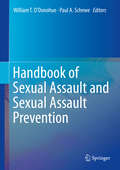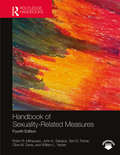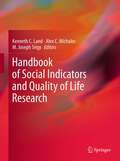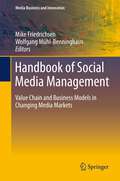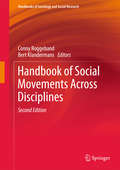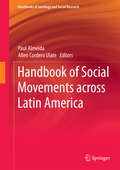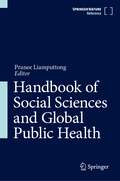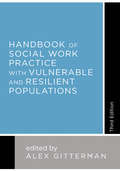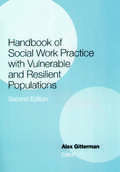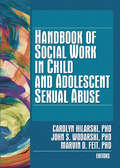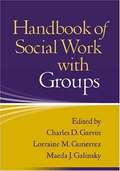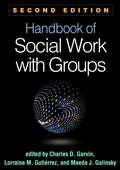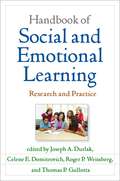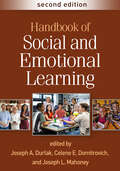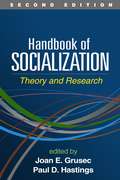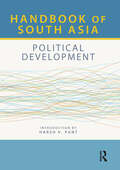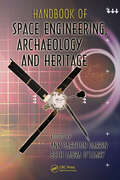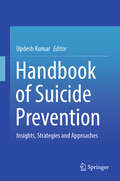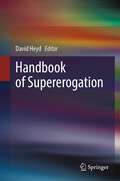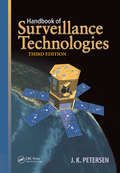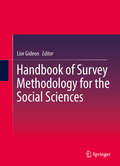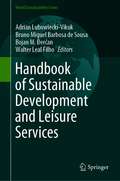- Table View
- List View
Handbook of Sexual Assault and Sexual Assault Prevention
by William T. O’Donohue Paul A. ScheweThis timely handbook provides in-depth overviews of the myriad and multi-faceted issues surrounding sexual assault and its pervasiveness in today’s culture. Drawing for multiple viewpoints and experts, the book is divided into seven comprehensive sections, covering such topics as risk factors, varying theoretical frameworks, prevention and intervention, and special populations. Within these sections the authors provide historical background as well as the latest research, and offer treatment outcomes and potentials.Selected topics covered in this book include: Feminist theories of sexual assaultSocial and economic factors surrounding sexual violenceMental, physiological, physical, and functional health concerns of victims, including PTSDMajor categories of sexual offendersTreatment of sexual assault survivors in the LGBTQ+ communityProcedural processes related to sexual assault investigation and adjudication within the criminal justice system The Handbook of Sexual Assault and Sexual Assault Prevention is a vital book that will appeal to a broad spectrum of students, researchers, practitioners, and clinicians in the fields of psychology, psychiatry, community mental health, and sociology.
Handbook of Sexuality-Related Measures
by William L. Yarber Terri D. Fisher Clive M. Davis Robin Milhausen John SakalukThis classic and invaluable reference handbook, written for sex researchers and their students, has now been completely revised in a new, fourth edition. It remains the only easy and efficient way for researchers to learn about, evaluate, and compare instruments that have previously been used in sex research.
Handbook of Social Indicators and Quality of Life Research
by Alex C. Michalos M. Joseph Sirgy Kenneth C. LandThe aim of the Handbook of Social Indicators and Quality of Life Research is to create an overview of the field of Quality of Life (QOL) studies in the early years of the 21st century that can be updated and improved upon as the field evolves and the century unfolds. Social indicators are statistical time series "...used to monitor the social system, helping to identify changes and to guide intervention to alter the course of social change". Examples include unemployment rates, crime rates, estimates of life expectancy, health status indices, school enrollment rates, average achievement scores, election voting rates, and measures of subjective well-being such as satisfaction with life-as-a-whole and with specific domains or aspects of life. This book provides a review of the historical development of the field including the history of QOL in medicine and mental health as well as the research related to quality-of-work-life (QWL) programs. It discusses several of QOL main concepts: happiness, positive psychology, and subjective wellbeing. Relations between spirituality and religiousness and QOL are examined as are the effects of educational attainment on QOL and marketing, and the associations with economic growth. The book goes on to investigate methodological approaches and issues that should be considered in measuring and analysing quality of life from a quantitative perspective. The final chapters are dedicated to research on elements of QOL in a broad range of countries and populations.
Handbook of Social Media Management: Value Chain and Business Models in Changing Media Markets
by Mike Friedrichsen Wolfgang Mühl-BenninghausDigitization and Web 2.0 have brought about continuous change from traditional media management to new strategic, operative and normative management options. Social media management is on the agenda of every media company, and requires a new set of specialized expertise on digital products and communication. At the same time, social media has become a vibrant field of research for media economists and media management researchers. In this handbook, international experts present a comprehensive account of the latest developments in social media research and management, consistently linking classical media management with social media. The articles discuss new theoretical approaches as well as empirical findings and applications, yielding an interesting overview of interdisciplinary and international approaches. The book's main sections address forms and content of social media; impact and users; management with social media; and a new value chain with social media. The book will serve as a valuable reference work for researchers, students and professionals working in media and public relations.
Handbook of Social Movements Across Disciplines
by Bert Klandermans Conny RoggebandThis book aims to revisit the interdisciplinary roots of social movement studies. Each discipline raises its own questions and approaches the subject from a different angle or perspective. The chapters of this handbook are written by internationally renowned scholars representing the various disciplines involved. They each review the approach their sector has developed and discuss their disciplines' contributions and insights to the knowledge of social movements. Furthermore, each chapter addresses the "unanswered questions" and discusses the overlaps with other fields as well as reviewing the interdisciplinary advances so far.
Handbook of Social Movements across Latin America
by Paul Almeida Allen Cordero UlateThis handbook covers social movement activities in Latin American countries that have had profound consequences on the political culture of the region. It examines the developments of the past twenty years, such as a renewed upswing in popular mobilization, the ending of violent conflicts and military governments, new struggles and a relatively more democratic climate. It shows that, from southern Chiapas to Argentina, social movements in the 1990s and especially in the 2000s, have reached new heights of popular participation. There is a lack of research on the politics of this region in the contemporary era of globalization, this volume partially fills the void and offers a rich resource to students, scholars and the general public in terms of understanding the politics of mass mobilization in the early twenty-first century. The contributors each address social movement activity in their own nation and together they present a multidisciplinary perspective on the topic. Each chapter uses a case study design to bring out the most prominent attributes of the particular social struggle(s), for instance the main protagonists in the campaigns, the grievances of the population and the outcomes of the struggles. This Handbook is divided into seven substantive themes, providing overall coherence to a broad range of social conflicts across countries, issues and social groups. These themes include: 1) theory of Latin American social movements; 2) neoliberalism; 3) indigenous struggles; 4) women's movements; 5) movements and the State; 6) environmental movements; and 7) transnational mobilizations.
Handbook of Social Sciences and Global Public Health
by Pranee LiamputtongThis handbook highlights the relevance of the social sciences in global public health and their significantly crucial role in the explanation of health and illness in different population groups, the improvement of health, and the prevention of illnesses around the world. Knowledge generated via social science theories and research methodologies allows healthcare providers, policy-makers, and politicians to understand and appreciate the lived experience of their people, and to provide sensitive health and social care to them at a time of most need. Social sciences, such as medical sociology, medical anthropology, social psychology, and public health are the disciplines that examine the sociocultural causes and consequences of health and illness. It is evident that biomedicine cannot be the only answer to improving the health of people. What makes social sciences important in global public health is the critical role social, cultural, economic, and political factors play in determining or influencing the health of individuals, communities, and the larger society and nation. This handbook is comprehensive in its nature and contents, which range from a more disciplinary-based approach and theoretical and methodological frameworks to different aspects of global public health. It covers: Discussions of the social science disciplines and their essence, concepts, and theories relating to global public health Theoretical frameworks in social sciences that can be used to explain health and illness in populations Methodological inquiries that social science researchers can use to examine global public health issues and understand social issues relating to health in different population groups and regionsExamples of social science research in global public health areas and concerns as well as population groups The Handbook of Social Sciences and Global Public Health is a useful reference for students, researchers, lecturers, practitioners, and policymakers in global health, public health, and social science disciplines; and libraries in universities and health and social care institutions. It offers readers a good understanding of the issues that can impact the health and well-being of people in society, which may lead to culturally sensitive health and social care for people that ultimately will lead to a more equitable society worldwide.
Handbook of Social Work Practice with Vulnerable and Resilient Populations
by Alex GittermanEvery day, social workers deal with individuals, families, and groups struggling with problems that are often chronic, persistent, acute, and/or unexpected. When community and family support systems are weak or unavailable, and when internal resources fail, these populations become vulnerable to physical, cognitive, emotional, and social deterioration.Yet despite numerous risk factors, a large number of vulnerable people do live happy and productive lives. This best-selling handbook examines not only risk and vulnerability factors in disadvantaged populations but also resilience and protective strategies for managing and overcoming adversity. This third edition reflects new demographic data, research findings, and theoretical developments and accounts for changing economic and political realities and immigration and health care policy reforms. Contributors have expanded their essays to include practice with individuals, families, and groups, and new chapters consider working with military members and their families, victims and survivors of terrorism and torture, bullied children, and young men of color.
Handbook of Social Work Practice with Vulnerable and Resilient Populations
by Alex GittermanWhen community and family support systems are weak or unavailable, and when internal resources fail, populations that struggle with chronic, persistent, acute, and/or unexpected problems become vulnerable to physical, cognitive, emotional, and social deterioration. Yet despite numerous risk factors, a large number of vulnerable people do live happy and productive lives. This best-selling handbook examines not only risk and vulnerability factors in disadvantaged populations but also resilience and protective strategies for managing and overcoming adversity. This third edition reflects new demographic data, research findings, and theoretical developments and accounts for changing economic and political realities, including immigration and health care policy reforms. Contributors have expanded their essays to include practice with individuals, families, and groups, and new chapters consider working with military members and their families, victims and survivors of terrorism and torture, bullied children, and young men of color.
Handbook of Social Work Practice with Vulnerable and Resilient Populations (2nd Edition)
by Alex GittermanThe second edition of this how-to-guide has been updated to reflect the field's growing understanding of resiliency and protective factors and their importance in forming balanced assessments and interventions. Individual chapters explore methods of coping with such problems as physical illness, homelessness, divorce and abuse. This edition also includes new chapters on crime victims, the death of a parent, gays and lesbians, single parenthood, and women of color.
Handbook of Social Work Practice with Vulnerable and Resilient Populations (NONE)
by Ed. Alex GittermanWhy do some people collapse under certain life conditions, while others remain relatively unscathed? What accounts for the marked variations in people's responses to stress and adversity? The second edition of this groundbreaking how-to guide has been extensively updated to reflect the field's growing understanding of the importance of resiliency and protective factors-the positive poles of the human experience-and the importance of their role in forming balanced assessments and responsive interventions.Individual chapters explore such problems as AIDS, chronic physical illness, depression, addiction, homelessness, divorce, and abuse. This new edition goes beyond the pathology explanatory model to stress such factors as courage, coping, and resourcefulness, and includes new chapters on such topics as crime victims and victim services, the death of a parent, gay and lesbian persons, single parenthood, and women of color.
Handbook of Social Work in Child and Adolescent Sexual Abuse
by John S. Wodarski Marvin D. Feit Carolyn HilarskiThe enlightening collection of new approaches to understanding sexual abuseWhen sexual abuse occurs, helping those directly affected can be a difficult and convoluted task. The Handbook of Social Work in Child & Adolescent Sexual Abuse is a comprehensive guide that provides the latest information on assessment, management, prevention, and policy. Through insightful and accessible discussions, this collection of essays encompasses the full spectrum of child and adolescent sexual abuse to shed needed light on an affecting issue. This innovative text is the up-to-date source for unique and compassionate ways of supporting and treating survivors.The increased attention given to child sexual abuse in recent years has revealed how little we know about this tragedy. The Handbook of Social Work in Child & Adolescent Sexual Abuse is the practical compendium that covers the already existing information regarding violence against children and delves into practical methods for treating those immediately affected by it. From its historical place in society to contemporary issues of prevention that have only recently come to light, contributors examine essential details in-depth and provide concise, empirical directions for short- and long-term support. Also included is the important and newly-available assessment and treatment information focusing on ethnicity, gender, and comorbid influences as they relate to family member treatment.Among the topics discussed in the Handbook of Social Work in Child & Adolescent Sexual Abuse are: historical views of and responses to sexual abuse risk and protective factors life stage consequences theories of family dysfunction comorbidity and attachment intrafamilial abuse the non-family offender current empirical assessment methods approaches to treatment in children approaches to treatment in adolescents neurological effects of abuse treatment for the non-offending caregiver the role of the internet and other media policy and practice implications the prevalence and consequences of abuse new methods of abuse prevention and child protection the etiology of sexual offending in an attachment framework and much more!The Handbook of Social Work in Child & Adolescent Sexual Abuse is an essential resource for educators, medical practitioners, psychologists, psychiatrists, social workers, counselors, family therapists, and students, researchers, and academics in the field of social work.
Handbook of Social Work with Groups
by Charles D. Garvin Maeda J. Galinsky Lorraine M. GutierrezGarvin (social work, University of Michigan) presents work by contributors in social work and public health describing current approaches to working with groups in a range of settings and for a variety of purposes. Authors outline influential theories of group work, reviewing findings from across the social and behavioral sciences, and address contemporary issues in planning and implementing interventions in areas including mental health, child welfare, substance abuse, aging, and corrections. They also look at community groups, groups in agencies, and policymaking groups. For each approach described, authors review relevant literature, provide practical information, assess the approach from the standpoint of empowerment, and consider issues specific to working with diverse populations. Several chapters are devoted to research issues. Annotation ©2004 Book News, Inc., Portland, OR (booknews.com)
Handbook of Social Work with Groups, Second Edition
by Charles D. Garvin Maeda J. Galinsky Lorraine M. GutiérrezThis definitive text, now revised and expanded, has introduced thousands of students and practitioners to the theory and practice of social work with groups. Leading authorities outline major models of group work and address critical issues in planning, implementing, and evaluating interventions. The Handbook describes applications in all the major practice settings--mental health, prevention, child welfare, substance abuse, health care, aging, corrections, and more--as well as organizational and community settings. A strong focus on empowerment, social justice, and diversity is woven throughout. The empirical foundations of group work are reviewed, and innovative research methods discussed. New to This Edition: *Incorporates over a decade of advances in the field *Heightened focus on practitioner-researcher collaboration. *Two chapters on substance abuse prevention with youth. *Chapters on social justice work, evidence-based practice, offender reentry, intimate partner violence, intergroup dialogue, working with immigrants and refugees, qualitative methods, and intervention research. *Major updates on existing topics, such as cognitive-behavioral group work, psychoeducational groups, health care settings, and technology-mediated groups. *Integrative epilogue that synthesizes key themes.
Handbook of Social and Emotional Learning
by Daniel Goleman James P. Comer Thomas P. Gullotta Linda Darling-Hammond Celene E. Domitrovich Roger P. Weissberg Timothy P. Shriver Jennifer Buffett Joseph A. DurlakThe burgeoning multidisciplinary field of social and emotional learning (SEL) now has a comprehensive and definitive handbook covering all aspects of research, practice, and policy. The prominent editors and contributors describe state-of-the-art intervention and prevention programs designed to build students' skills for managing emotions, showing concern for others, making responsible decisions, and forming positive relationships. Conceptual and scientific underpinnings of SEL are explored and its relationship to children's and adolescents' academic success and mental health examined. Issues in implementing and assessing SEL programs in diverse educational settings are analyzed in depth, including the roles of school- and district-level leadership, teacher training, and school-family partnerships.
Handbook of Social and Emotional Learning
by The Weissberg ScholarsThe definitive work on social and emotional learning (SEL) research and practice is now in an extensively revised second edition, featuring all-new and thoroughly updated chapters. The world&’s leading SEL scholars describe state-of-the-art interventions that build students' competencies for managing emotions, showing empathy for others, forming supportive relationships, and making responsible decisions. The scientific underpinnings of SEL are explored and its impact on academic achievement and behavior is examined. The Handbook discusses ways to assess SEL and design effective, developmentally and culturally informed programs for students in preschool through secondary school settings and beyond. New to This Edition *Reflects a decade of significant advances in research, policy, and implementation. *New and expanded topics--equity, culturally responsive practice, multi-tiered systems of support, adult SEL, technology tools and applications, mental health, scaling up successful interventions, and more. *Six chapters on international SEL efforts, discussing both developed and developing countries. *Every chapter concludes with Key Takeaway Points.
Handbook of Socialization, Second Edition
by Joan E. Grusec Paul D. HastingsThis highly regarded handbook remains the leading reference and advanced text on socialization. Bringing together foremost authorities, the volume reviews the breadth of current knowledge on socialization processes across the lifespan. Contributors present cutting-edge theories and findings pertaining to family, peer, school, community, media, and other influences on individual development. Genetics and biology, cultural psychology, and affective science are given particular attention. Three themes guide the book: the interdependence of biology and experience, the bidirectionality of socialization processes, and the many contributing factors that interact to produce multiple socialization processes and pathways. New to This Edition *Revised structure reflects the diversity of socializing relationships in multiple contexts across the lifespan. *Chapters on adolescence, socialization in the workplace, moral development, culture, and neuroscience. *Many new authors and extensively revised chapters.
Handbook of South Asia: Political Development
This Handbook brings together essays that introduce the reader to the key issues in South Asian political development. Written by experts in their respective areas, the essays explore key aspects of political economy, political and economic change, and the complex diplomatic and security challenges of individual countries and the region as a whole. Essays discuss topics as wide-ranging as China’s growing reach in South Asia, political Islam, SAARC and water politics through the region. This well-researched Handbook is an essential reference tool for students and scholars of Political Science, International Relations and South Asian studies.With an introduction by Harsh V Pant.
Handbook of Space Engineering, Archaeology, and Heritage (Advances in Engineering Series)
by Beth Laura O’Leary Ann Garrison DarrinSome might think that the 27 thousand tons of material launched by earthlings into outer space is nothing more than floating piles of debris. However, when looking at these artifacts through the eyes of historians and anthropologists, instead of celestial pollution, they are seen as links to human history and heritage.Space: The New Frontier for Ar
Handbook of State Aid for Film: Finance, Industries And Regulation (Media Business and Innovation Ser.)
by Matthias Karmasin Paul Clemens Murschetz Roland TeichmannThis book is an analysis of the specificities of public film funding on an international scale. It shows how public funding schemes add value to film-making and other audio-visual productions and provides a comprehensive analysis of today’s global challenges in the film industry such as industry change, digital transformation, and shifting audience tastes. Based on insights from fields such as cultural economics, media economics, media management and media governance studies, the authors illustrate how public spending shapes the financial fitness of national and international film industries. This highly informative book will help both scholars and practitioners in the film industry to understand the complexity of issues and the requirements necessary to preserve the social benefits of film as an important cultural good.
Handbook of Suicide Prevention: Insights, Strategies and Approaches
by Updesh KumarThe Handbook of Suicide Prevention covers a broad range of topics related to suicidal behaviour, including its underlying causes, risk factors, prevention strategies, and therapeutic approaches. With contributions by renowned experts in the field, the volume brings forth the latest research and clinical insights into suicidal behaviour. It highlights evidence-based practices effective in reducing suicide risk. It provides a comprehensive overview of the multidimensional perspectives, including biological, psychological, and social factors contributing to suicidal ideation and behaviour. The book provides a nuanced and extensive understanding of how suicide risk and protective factors are shaped by social, cultural, and political contexts across the lifespan. The last section of the volume highlights the need for a multifaceted approach to suicide prevention by leveraging the latest technologies and therapeutic modalities while also addressing the social and cultural factors that contribute to suicide risk. Suicidal behaviour remains an intriguing phenomenon that demands addressing being among the leading causes of death worldwide. The handbook is a compilation of essential resources that offers a multitude of theoretical and compassionate approaches to understanding and addressing this complex phenomenon. Its practical guidance and evidence-based recommendations make it an essential reference for anyone working in suicide prevention, mental health and social work.
Handbook of Supererogation
by David HeydSupererogation is the category of moral actions which go beyond the call of duty. This collection of articles is the first of its kind to cover the broad spectrum of issues related to supererogation. It provides an up-to-date status of the discussion on the main issues, alternative analyses, and controversies regarding central cases of supererogation. The work explores a broad range of philosophical problems and challenges our presuppositions about the basis of ethical theories. Beyond the challenges of supererogation to deontological and utilitarian views, this book presents the latest developments in the way virtue ethics approaches supererogation. It also discusses the issue of whether there is a negative analogue to the supererogatory: the suberogatory. The Handbook consists also of the first systematic discussion of supererogation from the point of view of five religions as well as a feminist analysis of the concept. The book is an essential read for philosophy scholars interested in moral philosophy.
Handbook of Surveillance Technologies
by J.K. Petersen Pamela TaylorFrom officially sanctioned, high-tech operations to budget spy cameras and cell phone video, this updated and expanded edition of a bestselling handbook reflects the rapid and significant growth of the surveillance industry. The Handbook of Surveillance Technologies, Third Edition is the only comprehensive work to chronicle the background and curre
Handbook of Survey Methodology for the Social Sciences
by Lior GideonSurveys enjoy great ubiquity among data collection methods in social research: they are flexible in questioning techniques, in the amount of questions asked, in the topics covered, and in the various ways of interactions with respondents. Surveys are also the preferred method by many researchers in the social sciences due to their ability to provide quick profiles and results. Because they are so commonly used and fairly easy to administer, surveys are often thought to be easily thrown together. But designing an effective survey that yields reliable and valid results takes more than merely asking questions and waiting for the answers to arrive. Geared to the non-statistician, the Handbook of Survey Methodology in Social Sciences addresses issues throughout all phases of survey design and implementation. Chapters examine the major survey methods of data collection, providing expert guidelines for asking targeted questions, improving accuracy and quality of responses, while reducing sampling and non-sampling bias. Relying on the Total Survey Error theory, various issues of both sampling and non-sampling sources of error are explored and discussed. By covering all aspects of the topic, the Handbook is suited to readers taking their first steps in survey methodology, as well as to those already involved in survey design and execution, and to those currently in training. Featured in the Handbook: * The Total Survey Error: sampling and non-sampling errors. * Survey sampling techniques. * The art of question phrasing. * Techniques for increasing response rates * A question of ethics: what is allowed in survey research? * Survey design: face-to-face, phone, mail, e-mail, online, computer-assisted.? * Dealing with sensitive issues in surveys. * Demographics of respondents: implications for future survey research. * Dealing with nonresponse, and nonresponse bias The Handbook of Survey Methodology in Social Sciences offers how-to clarity for researchers in the social and behavioral sciences and related disciplines, including sociology, criminology, criminal justice, social psychology, education, public health, political science, management, and many other disciplines relying on survey methodology as one of their main data collection tools.
Handbook of Sustainable Development and Leisure Services (World Sustainability Series)
by Walter Leal Filho Adrian Lubowiecki-Vikuk Bruno Miguel Barbosa de Sousa Bojan M. ĐerčanThis book reviews empirical and theoretical research on sustainable development in the context of leisure management for communities. Although leading research centers are pursuing interdisciplinary research on leisure in the context of sustainable development, there are still few papers that holistically address the current challenges in this area. In addition, demographic changes have made the promotion of a healthy lifestyle essential. Doing so requires responsible behavior on the part of various stakeholders in this market.This book fills an important gap in the literature and gathers contributions from an interdisciplinary and international team of authors, whose fields of expertise include human geography, management, intersections of sustainability and leisure, behavioral psychology and tourism.
